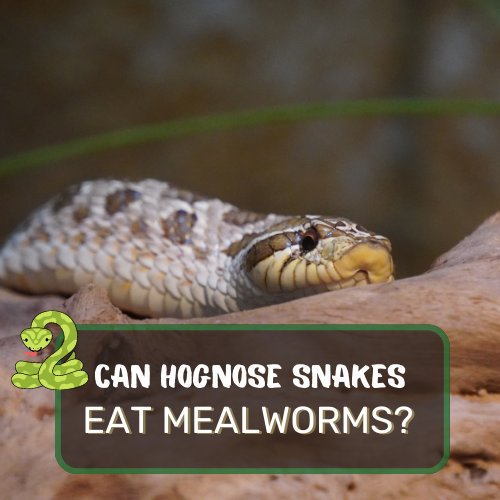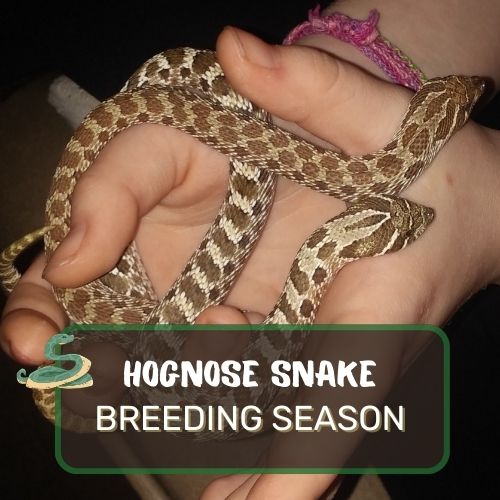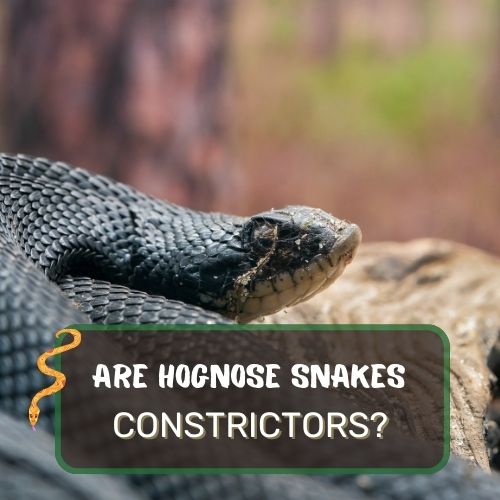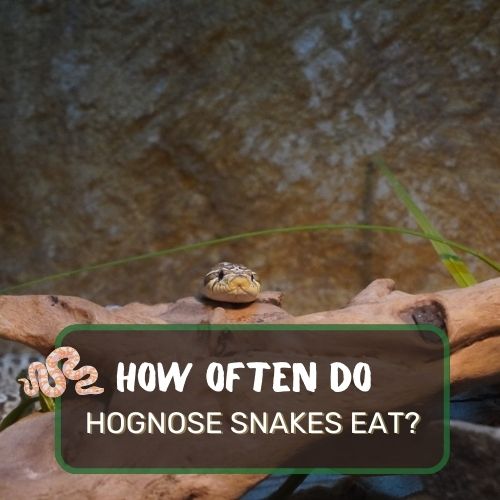
When it comes to the intriguing question, “Can hognose snakes eat mealworms?“, there’s more to consider than a simple yes or no.
Hognose snakes, with their distinctive upturned snouts, have unique dietary preferences that have piqued the curiosity of reptile enthusiasts worldwide.
In this article, we’ll delve deep into the natural diet of these fascinating creatures, explore the potential benefits and risks of introducing mealworms, and shed light on best feeding practices.
By diving into factors like nutritional value, feeding frequency, and health implications, you’ll gain a comprehensive understanding of what’s best for your slithering companion.
So, whether you’re a seasoned snake owner or just snake-curious, read on to unravel the mystery behind the hognose snake’s diet.
Table of Contents
- 1 Can Hognose Snakes Eat Mealworms? Short Answer
- 2 Benefits of Mealworms for Snakes
- 3 Potential Risks of Mealworms for Snakes
- 4 Natural Diet of Hognose Snakes
- 5 Other Suitable Foods for Hognose Snakes in Captivity
- 6 Feeding Practices for Hognose Snakes
- 7 Frequency of Feeding and Portion Sizes in Hognose Snakes
- 8 Health Concerns Related to Diet
- 9 Conclusion
- 10 FAQ
Can Hognose Snakes Eat Mealworms? Short Answer
Hognose snakes, known for their upturned snouts, primarily feed on amphibians and rodents in the wild. When it comes to mealworms, they aren’t a staple in their natural diet. However, some hognose snake owners have offered mealworms as an occasional treat or supplement. It’s essential to ensure the mealworms are appropriately sized and gut-loaded for added nutrition. While mealworms can be part of their captive diet, they shouldn’t replace the primary food sources like rodents.
Always consult with a reptile specialist or veterinarian to ensure a balanced and nutritious diet for your hognose snake.
Benefits of Mealworms for Snakes

When it comes to feeding snakes, especially those in captivity, variety is the spice of life. And mealworms? They’ve been a topic of debate for a while now. But let’s break down the benefits of these wriggly treats for our slithering friends.
Nutritional Value of Mealworms
First and foremost, mealworms pack a punch in the nutrition department. They’re rich in protein, which is essential for the growth and muscle development of snakes.
Moreover, they contain vital minerals and vitamins that can contribute to the overall health of the snake.
Here’s a breakdown of what they offer:
- Protein Powerhouses: Essential for muscle development and overall growth in snakes. Protein is the building block of life, and mealworms are rich in it.
- Essential Fatty Acids: These are crucial for:
- Energy production
- Cellular health
- Supporting brain function
- Minerals Galore: Mealworms are a source of:
- Calcium: Vital for bone health and muscle function.
- Phosphorus: Works hand-in-hand with calcium for bone strength.
- Vitamin Boost: Especially rich in:
- B-complex vitamins: These play a pivotal role in nerve function, metabolism, and overall well-being.
In essence, when you’re feeding your snake mealworms, you’re offering a balanced and varied nutritional profile that can complement their primary diet.
Think of them as the crunchy cereal of the reptile world – not a complete meal, but a beneficial supplement.
Ease of Breeding and Maintaining Mealworms
For those who’ve tried breeding rodents or other live feed, you know the hassle. Mealworms, on the other hand, are a breeze!
They require minimal space, and with some oatmeal and a slice of potato or apple for moisture, you’ve got yourself a mealworm farm. This ease of breeding means a consistent supply of fresh food for your snake.
Cost-Effectiveness Compared to Other Food Sources
Let’s talk economics. Maintaining a snake can be pricey, especially when considering their dietary needs. Mealworms, given their ease of breeding, can be a cost-effective alternative.
Instead of frequent trips to the pet store and shelling out cash, a one-time setup for a mealworm farm can lead to significant savings in the long run.

Potential Risks of Mealworms for Snakes
But, as with all things in life, it’s not all sunshine and rainbows. There are some concerns and myths associated with feeding mealworms to snakes.
The Urban Legend of Mealworms Eating Through Reptiles
We’ve all heard the tales – mealworms burrowing into the stomachs of reptiles, causing harm. But let’s set the record straight.
This is largely a myth. While mealworms are indeed survivors, the acidic environment of a snake’s stomach is not a place they can thrive or burrow.
The Actual Risk of Impaction and How It Occurs
Impaction is a genuine concern when feeding any reptile. It’s when the food causes a blockage in the digestive tract.
Mealworms, with their chitinous exoskeleton, can sometimes be harder to digest, especially if fed in large quantities or to a snake not used to such a diet. Always ensure the mealworms are appropriately sized for the snake and monitor their digestion.
The Debate on Mealworms’ Fat Content and Its Implications
Mealworms are fatty – there’s no denying that. And while fats are essential for snakes, especially during the colder months, an excessive fat diet can lead to obesity and related health issues. It’s all about balance.
If you’re feeding mealworms, ensure they’re just a part of a varied diet.
Natural Diet of Hognose Snakes

Hognose snakes, with their characteristic upturned snouts, are quite the spectacle in the reptile world. But what really sets them apart is their unique dietary preferences.
Predominant Preference for Toads
If hognose snakes had a favorite dish, it would undoubtedly be toads. These amphibians are their go-to meal in the wild. Picture this: a hognose snake, using its specialized snout, digging up a toad hiding beneath the soil.
It’s nature’s version of a treasure hunt!
Other Prey Items: Mice, Reptile Eggs, Insects, Salamanders, and Nesting Birds
While toads might be the favorite dish for hognose snakes, their diet in the wild is more varied than one might think. This adaptability ensures they get a well-rounded intake of nutrients.
Mice
Mice are a common prey for many snake species, and hognose snakes are no exception. Rich in protein and easily available, they make for a nutritious meal.
In captivity, many owners opt for frozen-thawed mice as they’re safer and free from potential parasites.
Reptile Eggs
Hognose snakes have been known to raid nests, feasting on the eggs of other reptiles. These eggs provide essential fats and proteins, making them a valuable food source.
Insects
Insects, especially beetles and other larger bugs, can be part of a hognose snake’s diet, especially when other preferred foods are scarce. They’re a crunchy treat packed with protein.
Salamanders
These amphibians, much like toads, are a delicacy for hognose snakes. Their soft bodies make them easy to swallow and digest.
Nesting Birds
On rare occasions, hognose snakes might prey on nesting birds, especially if the opportunity presents itself. This behavior showcases their adaptability and opportunistic nature.
In essence, hognose snakes are versatile eaters, ready to make the most of the food sources available to them.
The Role of Venom in Incapacitating Toads
Here’s a fun fact: hognose snakes possess a mild venom. While it’s not harmful to humans, it plays a crucial role in their diet.
This venom is especially effective against toads, helping the snake incapacitate its prey, making the mealtime a tad bit easier.

Other Suitable Foods for Hognose Snakes in Captivity
In captivity, the dietary needs of hognose snakes take a slight detour. While they might not have access to their favorite toads, there’s a smorgasbord of other options available.
Frozen Prey: Mice and Frog Leg Filets
Frozen mice are a staple for many captive snakes, and hognose snakes are no exception. They’re nutritious, easy to store, and safe. And for those looking to replicate the toad diet, frog leg filets can be a great alternative.
Commercially Produced Sausages Made with Frogs
In the ever-evolving world of pet care, innovation is key. Enter commercially produced sausages made specifically for reptiles. These sausages, often made with frogs, are packed with nutrition and are a hit among many hognose snake owners.
Importance of Pesticide-Free Prey for Health
Whether it’s a mouse, frog, or insect, ensuring the prey is pesticide-free is paramount. Pesticides can have detrimental effects on the snake’s health.
It’s always best to source food items from reputable suppliers to ensure the well-being of the snake.
Feeding Practices for Hognose Snakes
Feeding a hognose snake isn’t just about providing it with food; it’s about ensuring the snake has a wholesome experience that mimics its natural environment as closely as possible.

Importance of Variety in Diet
Just like us, hognose snakes thrive on a varied diet. While they have their favorites (hello, toads!), it’s essential to introduce different food items now and then.
This not only ensures they get a broad spectrum of nutrients but also keeps them mentally stimulated.
Using Tongs for Feeding
Safety first! Using tongs or forceps for feeding ensures a safe distance between your fingers and the snake. It also mimics the movement of live prey, making the feeding process more natural for the snake.
Frequency of Feeding and Portion Sizes
Frequency of Feeding and Portion Sizes in Hognose Snakes
Hognose snakes, with their unique appearance and behavior, have specific dietary needs that differ from other snake species. Ensuring they’re fed the right amount and at the right intervals is crucial for their well-being.

Frequency of Feeding:
- Young Hognose Snakes: Juvenile hognose snakes have a faster metabolism as they’re in their growth phase. As such, they require more frequent feedings, typically every 5-7 days.
- Adult Hognose Snakes: As they mature, their metabolic rate slows down a bit. Adult hognose snakes usually need a meal every 7-10 days. However, this can vary based on the snake’s activity level and overall health.
Portion Sizes:
- Size Matters: The general rule of thumb when feeding any snake, including hognoses, is to offer prey that’s roughly the same width as the snake’s body at its widest point. This ensures the snake can comfortably swallow and digest its meal.
- Variety: While hognose snakes have a penchant for toads, in captivity, they can be fed a mix of mice, frog leg filets, and insects. The key is to ensure the food item is appropriately sized, especially if you’re introducing a new food source.
Observing the Snake’s Behavior During Feeding
Always keep an eye out during feeding time. Is the snake showing interest? Is it having difficulty swallowing? Observations can provide valuable insights into the snake’s health and preferences.
Health Concerns Related to Diet
A snake’s diet directly impacts its health. Here are some concerns to be aware of:

Risks of Respiratory Infections
A diet that’s too cold or not properly thawed can lead to respiratory infections in snakes. Always ensure food is at room temperature before offering it.
Signs of Malnutrition or Overfeeding
Every snake owner wants their slithering companion to be in the pink of health. However, striking the right balance in their diet can sometimes be a challenge. Here’s how to spot the signs of malnutrition or overfeeding in your pet snake:
Malnutrition:
- Weight Loss: One of the most apparent signs of malnutrition is a noticeable weight loss. The snake’s spine and ribs become more visible, and its body might appear more triangular than round.
- Lethargy: A malnourished snake often lacks energy. If your snake seems less active or shows reduced interest in its surroundings, it might be a sign.
- Dull or Cloudy Eyes: While this can also be a sign of shedding, persistent dullness in the eyes outside of shedding periods can indicate poor nutrition.
- Poor Shedding: Malnourished snakes often have difficulty shedding their skin. Instead of one complete shed, the skin might come off in patches.
Overfeeding:
- Rapid Weight Gain: If your snake starts to look more rounded or plump, especially in the mid-body region, it might be consuming too many calories.
- Regurgitation: Overfeeding can lead to regurgitation. If your snake frequently brings up its food, it might be a sign that it’s eating too much or too often.
- Reduced Activity: Just like malnutrition, overfeeding can also lead to lethargy. An overfed snake might become less active and spend more time hiding.
- Difficulty Moving: Overweight snakes often have trouble moving around, especially when climbing.
In both cases, it’s essential to consult with a reptile veterinarian to address the issue and get guidance on proper feeding practices.
The Importance of Clean Water and Food
Dirty water or contaminated food can lead to a host of health issues, from digestive problems to infections. Always ensure the snake has access to clean water and that the food offered is fresh and from a reputable source.

Conclusion
In your journey to understand the dietary intricacies of hognose snakes, you’ve delved deep into their natural preferences, the potential of mealworms as a food source, and the essential feeding practices to ensure their well-being.
You’ve discovered that while toads might be their favorite, hognose snakes have a diverse palate, ranging from mice to nesting birds.
The question of “can hognose snakes eat mealworms?” isn’t just about the mealworms themselves, but about understanding the broader nutritional needs of these unique reptiles.
As you move forward, remember that the key to a healthy hognose snake is a balanced diet, careful observation, and continuous learning.
Every snake is an individual, and what works for one might not work for another. But with the knowledge you’ve gained, you’re well-equipped to make informed decisions for your scaly companion.
Keep up your passion and dedication, and remember: the world of reptiles is vast and ever-evolving, and there’s always something new to learn. Here’s to many happy, healthy years with your hognose snake!
FAQ
What can I feed my hognose snake?
Hognose snakes have a varied diet, but in the wild, they predominantly prefer toads. In captivity, they can be fed a diet of mice, frog leg filets, and certain insects like mealworms. It’s essential to ensure the food is appropriately sized and is free from pesticides or contaminants.
Can hognose snakes eat scrambled eggs?
While it might sound like an odd choice, some reptile enthusiasts have experimented with offering scrambled eggs to their pets. However, it’s not a natural food item for hognose snakes and should be given sparingly, if at all. Always ensure the eggs are cooked without any additives or seasonings.
How long can a hognose go without eating?
Hognose snakes, like other reptiles, can go for extended periods without food. Adult hognose snakes can typically go for a couple of weeks without eating, while younger ones might show signs of hunger sooner. However, prolonged refusal to eat can be a sign of underlying health issues and should be addressed with a veterinarian.
What is the best way to feed mealworms?
When offering mealworms, it’s best to use tongs to mimic the movement of live prey. Ensure the mealworms are gut-loaded, meaning they’ve been fed nutritious food before being offered to the snake, to maximize their nutritional value.
Are mealworms good for reptiles?
Mealworms can be a nutritious food source for many reptiles, including lizards and turtles. They’re rich in protein and can be a part of a balanced diet. However, they shouldn’t be the sole food source due to their high-fat content and should be combined with other dietary items for a well-rounded nutrition.




0 Comments